TSUKUBA FUTURE
#008 Turning Artistic Kicks into a Science
Professor ASAI Takeshi, Faculty of Health and Sport Sciences

J. League soccer turns 20 this year. The University of Tsukuba has produced many J. League players and national team members, including Masashi "Gon" Nakayama. While soccer remains popular worldwide, the recent trend has been toward flamboyant designs and colors for balls, uniforms, shoes, and related items. For example, soccer balls originally used to be plain white, but beginning in the 1960s, balls with 12 black pentagonal and 20 white hexagonal panels became standard, and colorful designs also appeared. In addition, with advances in manufacturing techniques, it became possible to produce balls that were almost perfectly spherical. As a result, ball flight characteristics also began to change.
Prof. Asai played defense during his days on the University of Tsukuba soccer team in his undergraduate days. After becoming a researcher and supervisor, he carried out sport science research in such areas as coaching techniques, kick technology, and physioscience. He says that the speed and flight distance of a kicked ball is determined by where on the foot it was kicked, and with how much force. In other words, to obtain speed and distance, one should kick as swiftly as possible, using the hardest part of the foot. Simple as it sounds, this has to coincide with free manipulation of the ball with spin and control, which can only be achieved by training the muscles and engaging in drills to polish technique. Coaching methods that emphasize goals and efficiency are important to enable players to master monotonous drills. Of course, shoes are also important. Prof. Asai's research also extends to working with manufacturers to improve shoes. He is even researching how soccer balls fly.
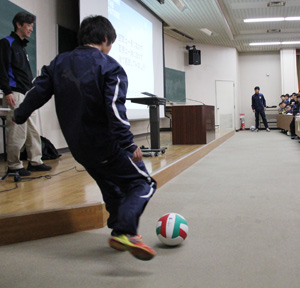
A moment in "The Science of the Free Kick," a special Kids University class held during the University of Tsukuba's Science and Technology Week in 2012
With each World Cup, the design of soccer balls approved by the International Federation of Association Football (FIFA) has been changed. The most recent major change was for the 2006 World Cup in Germany. Unlike conventional balls, which were covered with 12 pentagonal and 20 hexagonal panels for a total of 32 panels, the new ball, dubbed "+Teamgeist," was covered with 14 panels. And for the 2010 World Cup in South Africa, the number of panels on the "Jabulani" ball dropped to eight.
The number of panels fell because of the quest to develop a near-perfect spherical ball. However, as the ball became more spherical, its air resistance fell. This caused the ball to take an unpredictable path through the air when given a no-spin kick. Many will recall Keisuke Honda's signature no-spin shot. But unpredictable flight performance could not have sat well with the manufacturer. "The Albert," the official ball of the London Olympics, once again returned to a 32-panel configuration, and featured technical improvements. The "Cafusa" ball, which served as the official ball for the J. League in 2013 as well as for the Confederations Cup 2013 in Brazil, also had 32 panels.
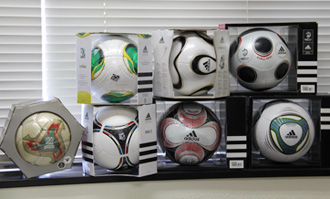
Official FIFA ball lineup, with green "Cafusa" ball at top left
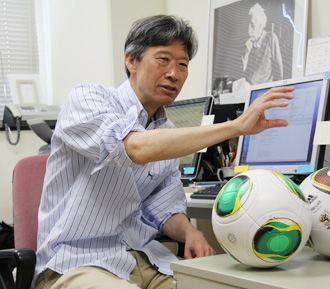
Prof. Asai with Cafusa
His research room is filled with athletic equipment and a poster of Einstein.
In collaboration with Yamagata University, Prof. Asai measured Cafusa's aerodynamic characteristics. The University of Tsukuba has a wind tunnel experiment facility that can measure the aerodynamic characteristics of athletic equipment. The tunnel, which can generate a maximum wind speed of 55 meters/second (198 kilometers/hour) and can be finely adjusted, is among the few such experimental facilities in Japan. Measurements obtained using this device indicate that Cafusa exhibits lower drag and can achieve higher speeds than +Teamgeist and Jabulani in the medium speed range (40 to 68 km/hour), while at the same time exhibiting higher drag in the high speed range (72 to 104 km/hour). In addition, with initial velocity of 60 km/hour, Cafusa's flight distance was longer, while with initial velocity of 100 km/hour, its flight distance was shorter than the other balls. One might say that Cafusa is superior for the kind of mid-speed, quick passing game used by Japan's national team, while Jabulani and +Teamgeist are more suited for a strategy of lofting high-speed long balls into the opponent's territory. Comparison of different balls also showed a longer total panel seam length means less possibility of turbulence and an unpredictable flight path. Cafusa, with its return to 32 panels, has a longer total seam length than balls with 14 or eight panels, making it less likely to behave unpredictably.
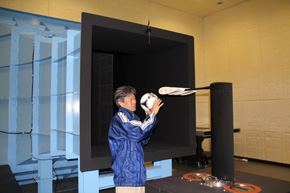
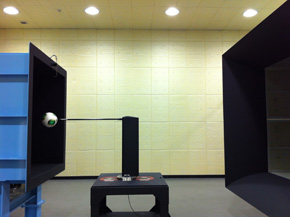
Tsukuba's wind tunnel testing device, a pride of the university
Prof. Asai's research extends to the aerodynamic characteristics of competition wear for bicycling and ski jumping. His research room is crammed with every type of soccer ball and a wide variety of other athletic equipment. And on the wall, a poster of Einstein with the famous quote, "Do not worry about your difficulties in mathematics. I can assure you mine are still greater." When asked about the poster, Prof. Asai noted that this quote made quite an impression on him. Research into aerodynamic performance of athletic equipment requires a grounding not only in sport science, but also in fluid dynamics involving mathematics. For Prof. Asai, whose strong point is not necessarily mathematics, Einstein's words have become a favorite motto. His advice to soccer players: to develop your skills, don't worry too much about equipment, but devote yourself to theory-based training. These are words to live by, and not just in the realm of soccer.
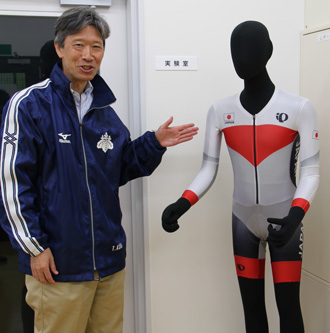
Prof. Asai was commissioned to carry out research for Japan's cycle team uniform for the London Olympics.
Article by Science Communicator at the Office of Public Relations


